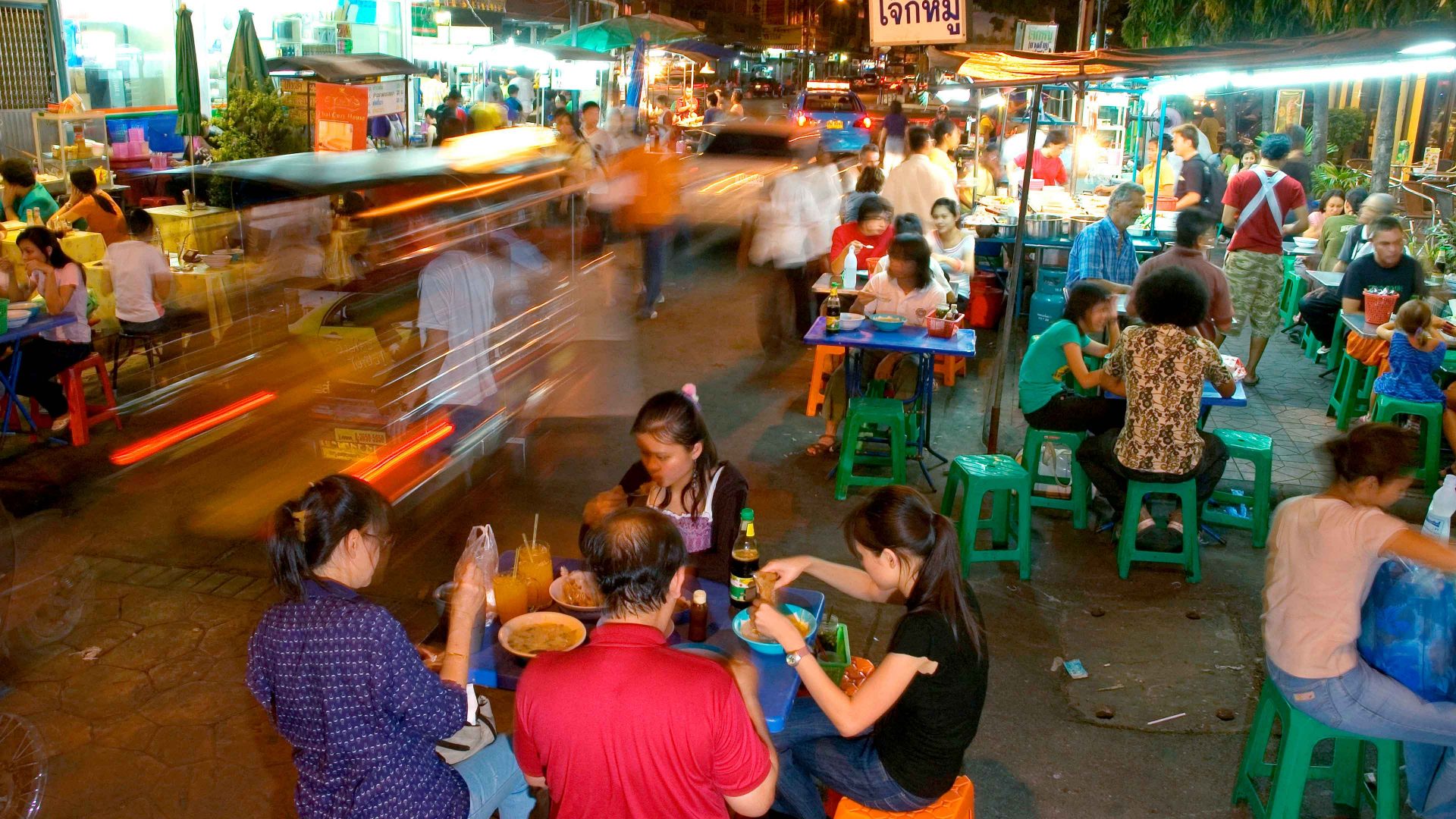I recall being in Thailand in the late 1980s – Bangkok, specifically. There was tourism, sure, but westerners weren’t in sufficient numbers to alter the character of the city, which was… intense: the Chao Phraya River, which worms though the tumult, was itself a tumult of high-speed fantail boats carrying commuters, the wash from which lifted the flotillas of sampans moored along its banks in a vast and compelling undulation: as if this were the lower-intestine of south-east Asia itself.
Then there was the street food – not that it was necessarily possible to decide where the street began or ended, since the land, like the water, was a Heraclitan flux: tuk tuks, cars, motorcycles and bicycles travelling at speed between fatalistic pedestrians who stopped at this or that stall to snack on whatever titbit it was they were deep frying with chilli, ginger, garlic and fish oil. Everything was so yummy, we never planned any meal times, simply browsed our way across town, like cows.
Albeit not of the sacred kind – and undoubtedly, one of the things that made Thai street food so much more congenial at that time than Indian was the deep-frying, which pretty much did for all those nasty little giardia viruses in quick-time. Anyway, Thai, Indian, Uigar… is there no land so remote, or so little-known nowadays that its cuisine can’t receive the descriptor “street” and be flogged from a stall at lunchtime to British workers?
All over central London, in its outer suburban centres, and I’ve no doubt throughout our ever-ravening realm, the same situation obtains: walking from one end to the other of Lower Marsh in Waterloo yesterday lunchtime, I counted no fewer than 42 food outlets, outing eats from all corners of the globe – there were four Thai ones alone! And yes, I’ve seen more than one Uigar stall, and quite a few Uzbek ones.
When I was in southern Armenia in 2017, one hot night I idly began considering whether it would be possible to drive from there through the ’stans to Beijing – there was only pesky old Iran getting in the way. Not a snacking destination for any journalist who’s worked for the BBC since they were dumb enough to let MI6 use their Tehran bureau as a listening post.
Anyway, I needn’t have felt frustrated – let alone hungry – since the Silk Road has now been paid out to me in the form of any number of Tupperware boxes full of tiffin. Ones which, for the most part I eschew, rather than chew – although, I remain intrigued by the way almost any new food vendor now lays claim to being “street”, as if this were a guarantor of authenticity.
Not that the Nigerian woman who’s cooking up a storm behind Brixton Post Office needs it: her establishment is about as street as it’s possible to be, without every square inch being covered in tarmac. Surrounded by corrugated iron fencing, and seated on a utilitarian trestle table that stood in turn on rough concrete hardstanding, I tucked into her prosaically named “meat soup”.
Prosaically – but not inaccurately: a greyish-brown broth of intense peppery-meatiness had the following wallowing in it: a quarter of a brain (species unidentifiable), two big chunks of kidney (likewise), and a veritable accordion of tripe.
I can’t imagine that many people are eating this much protein at a sitting in the teeming and notoriously immiserated alleyways of Lagos – but they should be: I only managed half my bowl, but ever since I’ve been strutting about like the cock of the walk. Hardly the effect my office lunches of yore used to have: “Ham and tomato on brown,” I would say, “D’you want mustard?” She would enquire, looking fetching – if spotty – in her white nylon snood. I would affirm – and she would further solicit: “Salt and pepper?”
You get the picture: a meagre half-hour break featuring a bog-standard sandwich, a can of Coke and a bag of crisps. If I had a job with luncheon vouchers, I might splash out on egg, sausage and chips at a cafe – either way, the dull food seemed to complement the dull jobs I had at that time.
Or did it? Talking to office workers in particular, I get the impression that contemporary corporate environments are more tedious still than they were in the era when I spent three weeks checking manually the product numbers of every single piece of Rank Xerox equipment being sent to the Olympic Games in Moscow. Perhaps this is why their lunches need to be so much more exotic: the two are in a direct ratio to one another.
Could this be evidence, yet again, of the bizarre way new technologies compensate for one another: as computerisation renders more and more office workers functionally inutile, they also make possible the globalised economy that adds a little spiciness to their lives?



